| Revision as of 17:59, 16 January 2015 view sourceAndiar.rohnds (talk | contribs)401 editsmNo edit summary← Previous edit | Revision as of 18:04, 16 January 2015 view source Andiar.rohnds (talk | contribs)401 editsm various minor corrections at lead sectionNext edit → | ||
| Line 37: | Line 37: | ||
| }} | }} | ||
| <!-- Per MOS:BOLDTITLE and WP:SBE, neither the article's title nor related text appears in bold. -->On 7 January 2015, at about 11:30 ] (10:30 ]), two masked gunmen forced their way into the offices of the French ] '']'' in ] killing 10 people. Two ] were also killed shortly after, and a total of 11 others had been injured. ''Charlie Hebdo'' had attracted attention for its controversial ]. | <!-- Per MOS:BOLDTITLE and WP:SBE, neither the article's title nor related text appears in bold. -->On 7 January 2015, at about 11:30 ] (10:30 ]), two masked gunmen forced their way into the offices of the French ] '']'' in ] killing 10 people. Two ] were also killed shortly after, and a total of 11 others had been injured during the attacks. ''Charlie Hebdo'' had attracted attention for its controversial ]. | ||
| The gunmen were armed with various weapons, including ] type assault rifles, ] submachine guns, a ], and a |
The gunmen were armed with various weapons, including ] type assault rifles, ] submachine guns, a ], and a rocket propelled launcher - possibly the ].<ref name="Zolja"/> They fired up to 50 shots with automatic weapons, shouting ''"]"'' (] for "God is greater").<ref name="all" /><ref name="live">{{cite web | url= http://www.bbc.co.uk/news/live/world-europe-30710777 | title = Charlie Hebdo attack – latest | publisher = BBC News | accessdate = 7 January 2015 | date = 7 January 2015}}</ref> | ||
| Police detained several people during the ] for the two main suspects. A third suspect voluntarily reported to a police station after hearing he was wanted, and was not charged. Police described the assailants as "armed and dangerous". France raised its ] to its highest level and deployed soldiers in ] and ]. | Police detained several people during the ] for the two main suspects. A third suspect voluntarily reported to a police station after hearing he was wanted, and was not charged. Police described the assailants as "armed and dangerous". France raised its ] to its highest level and deployed soldiers in ] and ]. | ||
| On 11 January 2015, up to 2 million people, including more than 40 world leaders, met in Paris for a ] to honour the 12 victims, along with 5 other victims who died in ]. In all, 3.7 million people joined demonstrations across France, in what officials called the largest public rally in France since ]. The phrase '']'' ({{language with name/for||French|"I am Charlie"}}) was a common slogan against the attacks. ] continued normal weekly publication, and the issue № 1178 sold out a print run of 5 million copies in six languages, in contrast to its typical French-only 60,000.<ref name="The Guardian 2015-01-14" /> | |||
| {{TOC limit|3}} | {{TOC limit|3}} | ||
Revision as of 18:04, 16 January 2015
This article has multiple issues. Please help improve it or discuss these issues on the talk page. (Learn how and when to remove these messages)
|
Further information: 2015 Île-de-France attacks
| Charlie Hebdo shooting | |
|---|---|
 Police officers, emergency vehicles, and journalists at the scene some two hours after the shooting Police officers, emergency vehicles, and journalists at the scene some two hours after the shooting | |
| Location | 10 Rue Nicolas-Appert, 11th arrondissement of Paris, France |
| Coordinates | 48°51′33″N 2°22′13″E / 48.85925°N 2.37025°E / 48.85925; 2.37025 |
| Date | 7 January 2015 (2015-01-07) 11:30 CET (UTC+01:00) |
| Target | Charlie Hebdo employees |
| Attack type | Mass shooting, terrorism |
| Weapons |
|
| Deaths | 12 |
| Injured | 11 |
| Perpetrators | Chérif and Saïd Kouachi |
On 7 January 2015, at about 11:30 CET (10:30 UTC), two masked gunmen forced their way into the offices of the French satirical weekly newspaper Charlie Hebdo in Paris killing 10 people. Two French National Police officers were also killed shortly after, and a total of 11 others had been injured during the attacks. Charlie Hebdo had attracted attention for its controversial depictions of Muhammad.
The gunmen were armed with various weapons, including AK-47 type assault rifles, Škorpion vz. 61 submachine guns, a shotgun, and a rocket propelled launcher - possibly the M80 Zolja. They fired up to 50 shots with automatic weapons, shouting "Allahu Akbar" (Arabic for "God is greater").
Police detained several people during the manhunt for the two main suspects. A third suspect voluntarily reported to a police station after hearing he was wanted, and was not charged. Police described the assailants as "armed and dangerous". France raised its terror alert to its highest level and deployed soldiers in Île-de-France and Picardy.
Attack
Charlie Hebdo headquarters
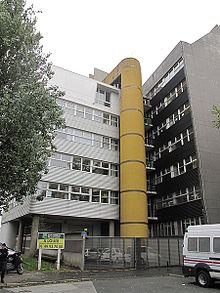
Before the shooting, the gunmen burst into number 6 Rue Nicolas-Appert, where the magazine's archives were based. The gunmen shouted, "Is this Charlie Hebdo?", before realising they had the wrong address and leaving. They then went to the magazine's headquarters at number 10 Rue Nicolas-Appert. Outside, they encountered cartoonist Corinne "Coco" Rey. She reported that the two armed and hooded men spoke perfect French threatened her to make her key in the code to open the door of the building.
The armed men sprayed the lobby with gunfire immediately upon entering the building. The first victim of the attack was maintenance worker Frédéric Boisseau, who was killed as he sat at the reception desk. The gunmen then forced Rey at gunpoint to lead them to a second-floor office, where 15 staff members were having an editorial meeting. It was Charlie Hebdo's first news conference of the year. Reporter fr [Laurent Léger] said that the meeting was interrupted by what they initially thought was the sound of a firecracker; this was the gunfire from the lobby. "We still thought it was a joke. The atmosphere was still joyous," he recalled.
Not long after, the gunmen burst into the meeting room and called out Charb's name to target him before opening fire. The shooting lasted five to ten minutes, the gunmen aiming at the journalists' heads and killing them execution-style. During the gunfire, Rey witnessed the murders of Wolinksi and Cabu. She survived uninjured by hurling herself under a desk. Léger also survived by hiding under a desk as the gunmen entered. Other witnesses reported that the gunmen identified themselves as belonging to Al-Qaeda in Yemen.
Psychoanalyst Elsa Cayat, who wrote a column in the paper, was killed. Crime reporter Sigolène Vinson survived; one of the shooters aimed at her but spared her life, saying "I'm not killing you because you are a woman" and telling her to read the Koran. She said he then left, shouting, "Allahu Akbar! Allahu Akbar!"
Escape
An authenticated video surfaced on the Internet, showing two gunmen and a wounded police officer, a Muslim, Ahmed Merabet, after an exchange of gunfire. The wounded officer was lying on a sidewalk near the corner of Boulevard Richard-Lenoir and Rue Moufle [fr], 180 metres (590 ft) east of the main crime scene. One of the murderers ran towards the policeman and shouted, "Did you want to kill me?" The policeman answered, "No, it's good, chief", and raised his hand toward the gunman, who then shot the policeman in the head at close range, killing him. Like the killers, Merabet was of Algerian descent. Thousands of people would later pay tribute to Merabet as a hero.
Sam Kiley, of Sky News, concluded from the video that the two gunmen were "military professionals" who likely have "combat experience", saying that the gunmen were exercising infantry tactics such as moving in "mutual support" and were firing aimed, single-round shots at the police officer. He also claimed that they were using military gestures.
The gunmen then left the scene, shouting (according to witnesses) "We have avenged the Prophet Muhammad. We have killed Charlie Hebdo!" They escaped in a getaway car, and drove to Porte de Pantin, hijacking another car on the way at the corner of Rue de Meaux and Passage de la Brie, forcing its driver out. As they drove away, they ran over a pedestrian and shot at responding police officers. Before driving away, one of the gunmen threw a sneaker that was seen lying beside the getaway car inside.
It was initially believed that there were three suspects. One identified suspect turned himself in at a Charleville-Mézières police station. Seven of the Kouachi brothers' friends and family were taken into custody. Jihadist flags and Molotov cocktails were found in an abandoned getaway car, a black Citroën C3.
Motive
Hatred for Charlie Hebdo's cartoons, which made jokes about Islamic leaders as well as Muhammad, is considered to be the principal motive for the massacre. Michael Morell, former deputy director of the CIA, suggested that the motive of the attackers was "bsolutely clear: trying to shut down a media organisation that lampooned the Prophet Muhammad".
In March 2013, Al-Qaeda's branch in Yemen, commonly known as Al-Qaeda in the Arabian Peninsula (AQAP), released a hit list in an edition of their English-language magazine Inspire. The list included Stéphane Charbonnier and others whom AQAP accused of insulting Islam. On 9 January, AQAP claimed responsibility for the attack in a speech from AQAP's top Shariah cleric Harith bin Ghazi al-Nadhari, citing the motive as "revenge for the honor" of Muhammad.
Victims
Killed
- Frédéric Boisseau, 42, building maintenance worker for Sodexo, killed in the lobby
- Franck Brinsolaro, 49, Protection Service police officer assigned as a bodyguard for Charb In 1996, Brinsolaro was one of those who evacuated 46 French citizens threatened by the Taliban in Afghanistan.
- Cabu (Jean Cabut), 76, cartoonist
- Elsa Cayat, 54, psychoanalyst and columnist. The only woman killed in the shooting.
- Charb (Stéphane Charbonnier), 47, cartoonist, columnist, and editor-in-chief of Charlie Hebdo
- Philippe Honoré, 74, cartoonist
- Bernard Maris, 68, economist, editor, and columnist
- Ahmed Merabet, 42, a Muslim police officer of Algerian descent, shot in the head as he lay wounded on the ground outside.
- fr [Mustapha Ourrad], 60, copy editor, an Algerian resident in France for 40 years
- Michel Renaud, 69, founder of fr [Rendez-vous du carnet de voyage de Clermont-Ferrand], a travel-themed art festival in Clermont-Ferrand, a guest at the meeting who was due to guest-edit an upcoming issue of Charlie Hebdo
- Tignous (Bernard Verlhac), 57, cartoonist
- Georges Wolinski, 80, cartoonist
- Charlie Hebdo shooting victims
-
 Cabu in 2012
Cabu in 2012
-
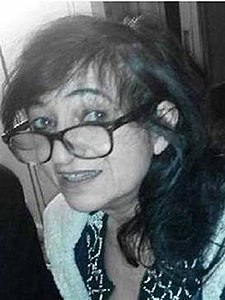 Elsa Cayat
Elsa Cayat
-
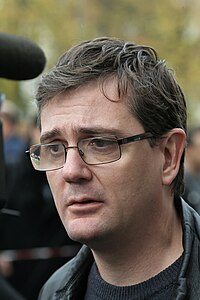 Charb in 2011
Charb in 2011
-
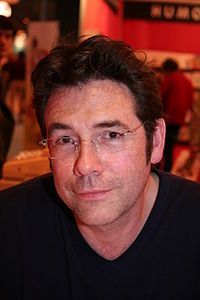 Tignous in 2008
Tignous in 2008
-
Wolinski in 2011
-
 Honoré in 2012
Honoré in 2012
Wounded
- Simon Fieschi, 31, webmaster— shot in the shoulder; shot in the spine and a lung perforated. He is in an induced coma since surgery.
- Philippe Lançon, journalist — shot in the face and in critical condition
- Fabrice Nicolino, 59, journalist — shot in the leg
- Laurent Sourisseau, 48, cartoonist — shot in the shoulder
- Unidentified police officers
Three people at the meeting were unharmed: Clermont-Ferrand book designer Gérard Gaillard, who was a guest, and two staff members, fr [Sigolène Vinson] and fr [Laurent Léger]; the cartoonist Coco, who was coerced into letting the murderers into the building, Rénald Luzier, the cartoonist "Luz", who had several times in the past contributed cartoons of Muhammad to Charlie Hebdo was not present at the meeting: by coincidence, he had slept in and was late for work.
The attacks are the deadliest act of terrorism in France since the 1961 Vitry-Le-François train bombing by the Organisation de l'armée secrète (OAS), a French dissident paramilitary organisation opposed to the independence of Algeria during the Algerian War (1954–62), when 28 people died.
Assailants
| It has been suggested that this article be split into a new article titled Chérif and Saïd Kouachi. (discuss) (January 2015) |
Chérif and Saïd Kouachi
| Chérif Kouachi | |
|---|---|
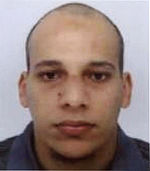 | |
| Born | (1982-11-29)29 November 1982 |
| Died | 9 January 2015(2015-01-09) (aged 32) |
| Saïd Kouachi | |
|---|---|
 | |
| Born | (1980-09-07)7 September 1980 |
| Died | 9 January 2015(2015-01-09) (aged 34) |
| Chérif and Saïd Kouachi | |
|---|---|
| Born | Paris, France |
| Cause of death | Gunshot wound |
| Nationality | French |
| Motive | Jihadism |
| Details | |
| Date | 7–9 January 2015 |
| Location(s) | Charlie Hebdo offices |
| Target(s) | Charlie Hebdo staff |
| Killed | 12 |
| Injured | 11 |
| Weapons | Škorpion vz. 61, Pump action shotgun, M80 Zolja |
Police quickly identified Saïd Kouachi (Template:IPA-fr; 7 September 1980 – 9 January 2015) and his brother Chérif Kouachi (Template:IPA-fr; 29 November 1982 – 9 January 2015) as the main suspects. The two Muslim French nationals, both born in Gennevilliers, were aged 34 and 32 respectively. Their parents were Algerian immigrants to France. The brothers were orphaned at a young age, and Chérif was raised in foster care in Rennes before he joined his brother in Paris.
Chérif, also known as Abu Issen, was part of the fr [Buttes-Chaumont network; "Buttes-Chaumont network"] (named after the Parc des Buttes Chaumont where they met and performed military-style training exercises); this group sent would-be jihadists to fight for al-Qaeda in Iraq after the 2003 invasion. He was arrested at age 22 in January 2005 when he and another man were about to leave for Bashar al-Assad's Syria – at the time a gateway for jihadists wishing to fight U.S. troops in Iraq. He went to Fleury-Mérogis Prison, where he met Amedy Coulibaly. In prison, they found a mentor, Djamel Beghal, who had been sentenced to 10 years in prison in France in 2001 for his part in a plot to bomb the United States embassy in Paris. Beghal had once been a regular worshipper at Finsbury Park mosque in London and a disciple of the radical preachers Abu Hamza and Abu Qatada.
Upon leaving prison, Chérif Kouachi married and got a job in a fish market on the outskirts of Paris. He became a student of Farid Benyettou, a radical Muslim preacher at the Addawa Mosque in the 19th arrondissement of Paris. Kouachi wanted to attack Jewish targets in France, but Benyettou told him that France, unlike Iraq, was not "a land of jihad".
In 2008, Chérif was convicted of terrorism and sentenced to three years in prison, with 18 months suspended, for having assisted in sending fighters to militant Islamist Abu Musab al-Zarqawi's group in Iraq, and for being part of a group that solicited young French Muslims to fight with Zarqawi, the leader of Al Qaeda in Iraq. He said outrage at the torture of inmates of the U.S. prison at Abu Ghraib inspired him to help Iraq's insurgency.
French judicial documents said Amedy Coulibaly and Chérif Kouachi traveled with their wives in 2010 to central France to visit Djamel Beghal. In a 2010 police interview, Coulibaly identified Chérif as a friend he had met in prison and said they saw each other frequently. In 2010, the Kouachi brothers were named in connection with a plot to break out from jail another Islamist, Smaïn Aït Ali Belkacem. They were not prosecuted due to a lack of evidence. Belkacem was one of those responsible for the 1995 Paris Métro and RER bombings that killed eight people.
From 2009 to 2010, Saïd Kouachi visited Yemen on a student visa to study at the San'a Institute for the Arabic Language. There, according to a Yemeni reporter who interviewed Saïd, he met and befriended Umar Farouk Abdulmutallab, the perpetrator of the attempted bombing of Northwest Airlines Flight 253 later in 2009. The two shared an apartment for "one or two weeks".
In 2011, Saïd returned to the country for a number of months and trained with al-Qaeda in the Arabian Peninsula militants. According to a senior Yemeni intelligence source, he met al Qaeda preacher Anwar al-Awlaki in the southern province of Shabwa. Chérif Kouachi told BFMTV that he had been funded by a network loyal to Anwar al-Awlaki, who was killed by a drone strike in 2011 in Yemen. According to U.S. officials, the U.S. provided France with intelligence in 2011 showing the brothers received training in Yemen. French authorities subsequently began monitoring them, but the surveillance came to an end in the spring of 2014. In the time preceding the Charlie Hebdo attack, Saïd had been living with his wife and children in a block of flats in Reims. Neighbours had described him as solitary.
The weapons used in the attack were supplied via the Brussels underworld. According to the Belgian press, a criminal sold Amedy Coulibaly the rocket-propelled grenade launcher and Kalashnikov assault rifles that Chérif and Saïd Kouachi and used at the Charlie Hebdo offices.
Alleged Charlie Hebdo attack driver
The police initially identified the 18-year-old brother-in-law of Cherif Kouachi, an unemployed French Muslim of North African descent and unknown nationality, as a third suspect in the shooting, accused of driving the getaway car. The man said he was in class at the time of the shooting, and that he rarely saw Cherif Kouachi. Many of his classmates said that he was present at school in Charleville-Mézières during the attack. After holding him for about 50 hours, police said that he was not being charged at that time.
After the attack
Manhunt
A massive manhunt began immediately after the attack. One suspect left his ID card in an abandoned getaway car. Police officers searched apartments in the Île-de-France region, in Strasbourg and in Reims.
At 10:30 CET on 8 January, the day following the attack, the two primary suspects were spotted in Aisne, north-east of Paris. Armed security forces, including the National Gendarmerie Intervention Group (GIGN) and the Force d'intervention de la police nationale (FIPN), were deployed to the department to search for the suspects.
Later that day, the police search concentrated on the Picardy region, particularly the area around Villers-Cotterêts and the village of Longpont, after the suspects robbed a petrol station near Villers-Cotterêts, then reportedly abandoned their car before hiding in a forest near Longpont. Searches continued into the surrounding Forêt de Retz (130 km), one of the largest forests of France.
The manhunt continued with the discovery of the two fugitive suspects early in the morning of 9 January. The Kouachis had hijacked a Peugeot 206 near the town of Crépy-en-Valois. They were chased by police cars for approximately 27 kilometres south down the N2 trunk road. At some point they abandoned their vehicle and an exchange of gunfire between pursuing police and the brothers took place near the commune of Dammartin-en-Goële, 35 kilometres (22 mi) northeast of Paris. Several blasts went off as well and Saïd Kouachi sustained a minor neck wound. Several others may have been injured as well but no one was killed in the gunfire. The suspects were not apprehended and escaped on foot.
Dammartin-en-Goële hostage crisis
At around 9:30 a.m., the Kouachi brothers fled into the office of Création Tendance Découverte, a signage production company on an industrial estate in Dammartin-en-Goële. Inside the building were owner Michel Catalano and a male employee, 26-year-old graphics designer Lilian Lepère. Catalano sent Lepère to hide in the refectory and remained in his office himself. Not long after, a salesman named Didier went to the printworks on business. Catalano came out with Chérif Kouachi who introduced himself as a police officer. They shook hands and Kouachi told Didier, "Leave. We don't kill civilians anyhow." These words were what caused Didier to guess that Kouachi was a terrorist and he alerted the police.
The Kouachi brothers remained inside and a lengthy standoff began. Michel Catalano re-entered the building and closed the door after Didier had left. The brothers were not aggressive towards Catalano, who stated, "I didn't get the impression they were going to harm me." He made coffee for them and helped bandage the neck wound that Saïd Kouachi had sustained during the earlier gunfire. Catalano was allowed to leave after an hour. Catalano swore three times to the terrorists that he was alone and did not reveal Lepère's presence. The Kouachi brothers were never aware of him being there. Lepère hid inside a cardboard box and sent the police text messages for around three hours during the siege, providing them with "tactical elements such as location inside the premises".
Given the proximity (10 km) of the siege to Charles de Gaulle Airport, two of the airport's runways were closed.Interior Minister Bernard Cazeneuve called for a police operation to neutralise the perpetrators. However, an Interior Ministry spokesman announced that the Ministry wished first to "establish a dialogue" with the suspects. Officials tried to establish contact with the suspects to negotiate the safe evacuation of a school 500 m from the siege. The Kouachi brothers did not respond to attempts at communication by the French authorities.
The siege lasted for eight to nine hours, and at around 4:30 p.m. there were at least three explosions near the building. At around 5:00 p.m., a police team landed on the roof of the building and a helicopter landed nearby. Before police could reach them, the pair ran out of the building and opened fire on police. The brothers had stated a desire to die as martyrs and the siege came to an end when both Kouachi brothers were gunned down. Lilian Lepère was rescued unharmed. A cache of weapons, including Molotov cocktails and an M80 Zolja, was found in the area.
Background
Charlie Hebdo satirical works
Main article: Charlie HebdoCharlie Hebdo (Template:IPA-fr; French for Weekly Charlie) is a satirical weekly newspaper in France that features cartoons, reports, polemics, and jokes. The publication is irreverent and stridently non-conformist in tone, is strongly secularist, antireligious and left-wing, and publishes articles that mock far-right politics, Catholicism, Islam, Judaism, Israel, politics, culture, and various other groups as local and world news unfolds. The magazine was published from 1969 to 1981, and again from 1992 on.

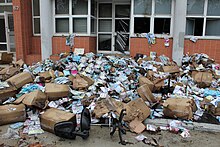
Charlie Hebdo has a history of attracting controversy. Islamic organisations unsuccessfully sued in 2006 over the newspaper's re-publication the Jyllands-Posten cartoons of Muhammad, the founder of Islam. The cover of a 2011 issue retitled "Charia Hebdo" (a pun on Sharia), featured a cartoon of Muhammad, whose depiction is forbidden in some interpretations of Islam. The newspaper's office was fire-bombed and its website hacked. In 2012, the newspaper published a series of satirical cartoons of Muhammad, including nude caricatures; this came days after a series of violent attacks on U.S. embassies in the Middle East, purportedly in response to the anti-Islamic film Innocence of Muslims, prompting the French government to close embassies, consulates, cultural centres, and international schools in about 20 Muslim countries. Riot police surrounded the newspaper's offices to protect it against possible attacks. Writing in 2013, former contributor Olivier Cyran said the magazine, firstly under former editor Philippe Val, and continuing with Charbonnier, had made Islamophobia its 'staple diet'. A rapper called for a “burning at the stake for those Charlie Hebdo dogs”, on the soundtrack of the film La Marche.
Cartoonist Stéphane "Charb" Charbonnier, murdered in the attack on the magazine, was the editor-in-chief of Charlie Hebdo from 2009. Two years before the attack he stated, "We have to carry on until Islam has been rendered as banal as Catholicism." In 2013, al-Qaeda added him to its most wanted list, along with three Jyllands-Posten staff members: Kurt Westergaard, Carsten Juste, and Flemming Rose.
Numerous violent plots related to the Jyllands-Posten cartoons were discovered, primarily targeting cartoonist Kurt Westergaard, editor Flemming Rose, and the property or employees of Jyllands-Posten and other newspapers that printed the cartoons. Westergaard was the subject of several attacks and planned attacks, and lives under police protection. On 1 January 2010, police used guns to stop a would-be assassin in his home. The attacker was sentenced to nine years in prison. In 2010, three men based in Norway were arrested on suspicion of planning a terror attack against Jyllands-Posten or Kurt Westergaard; two of them were convicted. In the United States, David Headley and Tahawwur Hussain Rana were convicted of planning terrorism against Jyllands-Posten, and were sentenced in 2013.
Laïcité and blasphemy
See also: Laïcité and Islam and blasphemyIn France, the principle of laïcité – the separation of church and state – was enshrined in the 1905 law on the Separation of the Churches and the State. Under its terms, people are free to practise the religion of their choice in the private sphere, but are required to keep religion out of the public sphere. Authors, humorists, cartoonists, and individuals have the right to satirise people, public actors, and religions, a right which is balanced by defamation laws. These rights and legal mechanisms were designed and used to protect freedom of speech from local powers, among which was the then powerful Catholic Church in France.
Images of Muhammad are not banned in Islam. Many satirists in Muslim countries mock autocrats, corruption, reactionaries, and jihadis, though there are no Charlie Hebdo-style cartoons portraying Muhammad. Some Muslims, however, take the view that the satire of religion, of religious representatives and—above all—of the Muslim prophet is forbidden blasphemy in Islam and that it can be punished by death. According to the BBC, France has seen "the apparent desire of some younger, often disaffected children or grandchildren of immigrant families not to conform to western, liberal lifestyles – including traditions of religious tolerance and free speech".
Aftermath

Related events on 7–9 January
Main article: 2015 Île-de-France attacks § AttacksFrance
See also: Survivors' issue of Charlie HebdoThe remaining staff of Charlie Hebdo continued normal weekly publication, and the following issue sold out a print run of 5 million copies in six languages, in contrast to its typical French-only 60,000. The cover depicts Muhammad holding a "Je suis Charlie" sign, and is captioned; "All is forgiven". The "survivors' issue" of Charlie Hebdo was also to be sold outside France. The Digital Innovation Press Fund donated €250,000 to support the magazine, matching a donation by the French Press and Pluralism Fund. The Guardian Media Group pledged a separate donation of £100,000 to the same cause.
On the night of 8 January, police commissioner Helric Fredou, who had been investigating the attack, committed suicide in his office in Limoges shortly after meeting with the family of one of the victims, while he was preparing his report. He was said to have been experiencing depression and burnout.
Security
– High chance of threat (threat level 3)
– Definite threat (threat level 4)
Following the attack, France raised its terror alert to its highest level and deployed soldiers in Paris to the public transport system, media offices, places of worship and the Eiffel Tower. The British Foreign Office warned its citizens about travelling to Paris. The New York City Police Department ordered extra security measures to the offices of the Consulate General of France in New York in Manhattan's Upper East Side as well as the Lycée Français de New York, which was deemed a possible target due to the proliferation of attacks in France as well as the level of hatred of the United States within the extremist community. In Denmark, which was the centre of a controversy over cartoons of Muhammad in 2005, security was increased at all media outlets.
Hours after the shooting, Spanish Interior Minister Jorge Fernández Díaz said that Spain's anti-terrorist security level had been upgraded, and that the country was sharing information with France in relation to the attacks. Spain increased security around public places such as railway stations and increased the police presence on streets throughout the country's cities.
The British Transport Police confirmed on 8 January that they would establish new armed patrols in and around St Pancras International railway station in London, following reports that the suspects were moving north towards Eurostar stations. They confirmed that the extra patrols were for the reassurance of the public and to maintain visibility and that there were no credible reports yet of the suspects heading towards St Pancras.
In Belgium, the staff of P-Magazine has been given police protection, although there were no specific threats. P-Magazine had previously published a cartoon of Muhammad drawn by the Danish cartoonist Kurt Westergaard.
Demonstrations
7 January
Further information: Je suis Charlie
On the evening of the day of the attack, demonstrations against the shootings were held at the Place de la République in Paris and in other cities including Toulouse, Nice, Lyon, Marseille and Rennes. These gatherings led to 8 January being declared as an official day of mourning by President François Hollande.
The phrase Je suis Charlie (Error: {{language with name/for}}: missing language tag or language name (help)) has come to be a common worldwide sign of solidarity against the attacks. Many demonstrators used the slogan to express solidarity with the magazine. It was used as the hashtag #jesuischarlie on Twitter, as printed or hand-made placards, and displayed on mobile phones at vigils, and on many websites, particularly media sites such as Le Monde. Je suis Charlie quickly trended at the top of Twitter hashtags worldwide following the attack. The United States Embassy in Paris changed its Twitter profile picture to the "Je suis Charlie" placard.
Not long after the attack, it is estimated that around 35,000 people gathered in Paris holding "Je suis Charlie" signs. 15,000 people also gathered in Lyon and Rennes. 10,000 people gathered in Nice and Toulouse; 7,000 in Marseille; and 5,000 each in Nantes, Grenoble and Bordeaux. Thousands also gathered in Nantes at the Place Royale. More than 100,000 people in total gathered within France to partake in these demonstrations the evening of 7 January.
- Protests in France
-
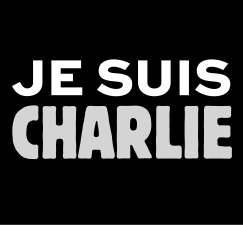 The "I am Charlie" slogan became an endorsement of freedom of speech and press
The "I am Charlie" slogan became an endorsement of freedom of speech and press
-
 Demonstrators gather at the Place de la République in Paris on the night of the attack
Demonstrators gather at the Place de la République in Paris on the night of the attack
-
Memorial for Ahmed Merabet
-
Demonstrators in Bordeaux
-
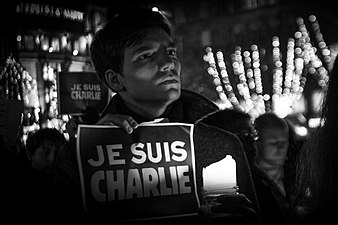 Tribute to Charlie Hebdo in Strasbourg
Tribute to Charlie Hebdo in Strasbourg
-
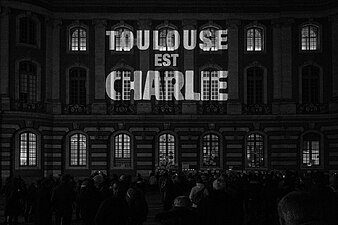 Tributes to the victims in Toulouse
Tributes to the victims in Toulouse
Similar demonstrations and candle vigils spread to other cities outside of France as well, including Amsterdam, Brussels, Barcelona, Ljubljana, Berlin, Copenhagen, London and Washington, D.C. Around 2,000 demonstrators gathered in London's Trafalgar Square and sang La Marseillaise, the French national anthem. In Brussels, two vigils have been held thus far, one immediately at the city's French consulate and a second one at Place du Luxembourg. Many flags around the city were at half-mast on 8 January. On the other side of the Atlantic, a crowd gathered on the same evening, 7 January, at Union Square in Manhattan, New York City. French ambassador to the United Nations Francois Delattre was present; the crowd lit candles, held signs, and sang the French national anthem. Several hundred people also showed up outside of the French consulate in San Francisco with "Je suis Charlie" signs to show their solidarity. In downtown Seattle, another vigil was held where people gathered around a French flag laid out with candles lit around it. They prayed for the victims and held "Je suis Charlie" signs. Further south in Argentina, a large demonstration was held to denounce the attacks and show support for the victims outside the French embassy in the capital Buenos Aires.
More vigils and gatherings were held in Canada to show support to France and condemn terrorism. Many cities had notable "Je suis Charlie" gatherings, including Calgary, Montreal, Ottawa and Toronto. In Calgary, there was a strong anti-terrorism sentiment. "We're against terrorism and want to show them that they won't win the battle. It's horrible everything that happened, but they won't win," commented one demonstrator. "It's not only against the French journalists or the French people, it's against freedom – everyone, all over the world, is concerned at what's happening." In Montreal, despite a temperature of −21 °C (−6 °F), over 1,000 people gathered chanting "Liberty!" and "Charlie!" outside of the city's French Consulate. Montreal Mayor Denis Coderre was among the gatherers and proclaimed, "Today, we are all French!" He confirmed the city's full support for the people of France and called for strong support regarding freedom, stating that "We have a duty to protect our freedom of expression. We have the right to say what we have to say."
8 January
By 8 January, the vigils had also spread to Australia. Gatherings had formed in Sydney, Melbourne, and Perth, with thousands of people holding up "Je suis Charlie" signs. In Sydney, people gathered at Martin Place – the location of a siege less than a month earlier – and in Hyde Park dressed in white clothing as a form of respect; flags were at half-mast at the city's French consulate where bouquets of flowers had been left by mourners. A vigil was held at Federation Square in Melbourne with an emphasis on togetherness. The gathering in Perth was described by French consul Patrick Kedemos as "a spontaneous, grass roots event". He added, "We are far away but our hearts today with our families and friends in France. It an attack on the liberty of expression, journalists that were prominent in France, and at the same time it's an attack, or a perceived attack on our culture."
In the evening of 8 January over a 100 demonstrations were held from 18:00 in the Netherlands at the time of the silent march in Paris, after the mayors of Amsterdam, Rotterdam and Utrecht and later more mayors called to do so. Many Dutch government members joined the demonstrations.
- Protests around the world
-
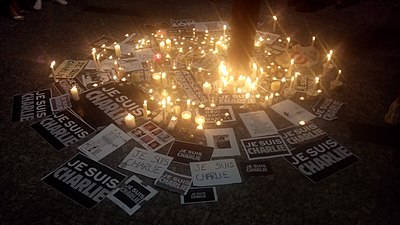 Brisbane, Australia
Brisbane, Australia
-
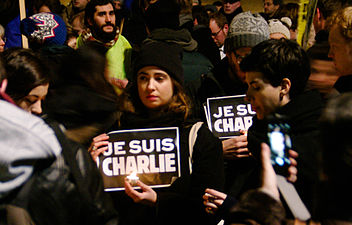 Berlin, Germany
Berlin, Germany
-
 Luxembourg, 8 January 2015
Luxembourg, 8 January 2015
-
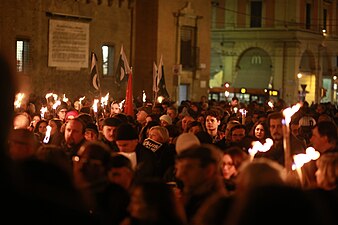 Bologna, Italy
Bologna, Italy
-
 Chicago, USA
Chicago, USA
-
 French Embassy, Moscow, Russia
French Embassy, Moscow, Russia
-
 Brussels, Belgium
Brussels, Belgium
-
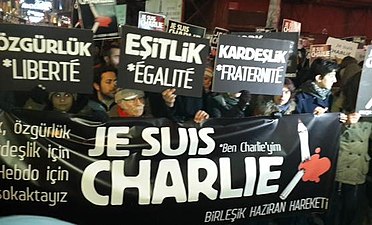 Istanbul, Turkey
Istanbul, Turkey
10–11 January
Main article: Republican marchesAround 700,000 people walked in protest in France on 10 January, with major marches being held in Toulouse (attended by 100,000), Marseille (45,000), Lille (35–40,000), Nice (23–30,000), Pau (80,000), Nantes (75,000), Orléans (22,000), and Caen (6,000).
On 11 January 2015, up to 2 million people including President Hollande and more than 40 world leaders led a "unity rally", organised to show unity after the attacks, streaming into the heart of Paris for a rally of national unity to honour the 17 victims. The demonstrators marched from Place de la République to Place de la Nation, with more than one million people joining in. In all, 3.7 million people joined demonstrations nationwide, in what officials called the largest public rally in France since World War II.
There were also large marches in many other French towns and cities — perhaps three million people throughout France — along with marches and vigils in many other cities worldwide.
- Republican marches on 11 January in France
-
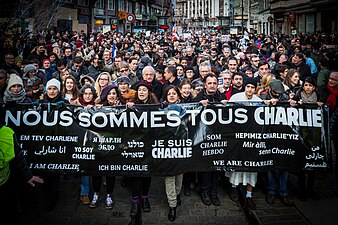 Strasbourg
Strasbourg
-
 fr [Boulevard Beaumarchais], Paris
fr [Boulevard Beaumarchais], Paris
-
Chambéry
-
 Rennes
Rennes
Apology of terrorism
About 54 persons in France, who had publicly supported the attack on Charlie Hebdo, were arrested for "Apology of terrorism" and about 12 people were condemned to several months in jail. Comedian Dieudonné faces the same charges for having tweeted "I feel like Charlie Coulibaly".
Reactions
French government
President François Hollande addressed media outlets at the scene of the shooting and called it "undoubtedly a terrorist attack", adding that "several terrorist attacks were thwarted in recent weeks". He later described the shooting as a "terrorist attack of the most extreme barbarity", called the slain journalists "heroes", and declared a day of national mourning on 8 January.
At a rally in the Place de la République in the wake of the shooting, Mayor of Paris Anne Hidalgo said, "What we saw today was an attack on the values of our republic, Paris is a peaceful place. These cartoonists, writers and artists used their pens with a lot of humour to address sometimes awkward subjects and as such performed an essential function." She proposed that Charlie Hebdo "be adopted as a citizen of honour" by Paris.
French Prime Minister Manuel Valls said that his country was at war with terrorism, but not at war with Islam or Muslims.French foreign minister Laurent Fabius said "The terrorists’ religion is not Islam, which they are betraying. It's barbarity."
Other countries
Main article: International reactions to the Charlie Hebdo shooting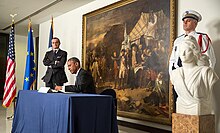
The attack received immediate and swift condemnation from dozens of governments worldwide. Statements of condolence and outrage were offered by many international leaders including Barack Obama, Vladimir Putin, Stephen Harper, Angela Merkel, Matteo Renzi, David Cameron and Tony Abbott.
Media
Some English-language media outlets republished the controversial cartoons on their websites in the hours following the shootings. Prominent examples included Bloomberg News, The Huffington Post, The Daily Beast, Gawker, Vox, and The Washington Free Beacon.
Other news organisations covered the shootings without showing the controversial drawings, such as The New York Times, New York Daily News, CNN, Al-Jazeera America, Associated Press and The Daily Telegraph. Two websites accused the latter group of self-censorship. The BBC, which previously had guidelines against all depictions of Muhammad, showed a depiction of him on a Charlie Hebdo cover and announced that they were reviewing these guidelines.
Other media publications such as Germany's Berliner Kurier and Poland's Gazeta Wyborcza reprinted cartoons from Charlie Hebdo the day after the attack; the former had a cover of Muhammad reading Charlie Hebdo whilst bathing in blood. At least three Danish newspapers featured Charlie Hebdo cartoons, and the tabloid BT used one on the cover, depicting Muhammad lamenting being loved by "idiots". The German newspaper Hamburger Morgenpost re-published cartoons, and their office was fire-bombed. In Russia, LifeNews and Komsomolskaya Pravda suggested that the United States had carried out the attack. "We are Charlie Hebdo" appeared on the front page of Novaya Gazeta.
In China, state-run Xinhua advocated limitation on freedom of speech, while another state-run newspaper Global Times said the attack is "payback" for the West's colonialism.
Media organisations carried out protests against the shootings. Libération, Le Monde, and Le Figaro, along with other French media outlets, used black banners carrying the slogan "Je suis Charlie" across the top of their websites. The front page of Libération's printed version was a different black banner, stating, "Nous sommes tous Charlie" (We are all Charlie), while Paris Normandie renamed itself Charlie Normandie for the day. The French, and later the UK, versions of Google displayed a black ribbon of mourning on the day of the attack.
Ian Hislop, editor of the British satirical magazine Private Eye, released a statement, saying, "I am appalled and shocked by this horrific attack – a murderous attack on free speech in the heart of Europe. ... Very little seems funny today." The editor of Titanic, a German satirical magazine, declared "we are scared when we hear about such violence. However, as a satirist, we are beholden to the principle that every human being has the right to be parodied. This should not stop just because of some idiots who go around shooting". Many cartoonists from around the world responded to the attack on Charlie Hebdo by posting cartoons relating to the shooting. Among them was Albert Uderzo, the creator of Astérix, who came out of retirement at the age of 87 to depict his title character supporting Charlie Hebdo. In Australia, what was considered the iconic national cartoonist's reaction was a cartoon by David Pope in the Canberra Times, depicting a masked, black-clad figure with a smoking rifle standing poised over a slumped figure of a cartoonist in a pool of blood, with a speech balloon showing the gunman saying "He drew first".
Egyptian daily Al-Masry Al-Youm featured drawings by young cartoonists signed with "Je suis Charlie" in solidarity with the victims. Al-Masry al-Youm also displayed on their website a slide show of some Charlie Hebdo cartoons, including controversial ones. This was seen by analyst Jonathan Guyer as a "surprising" and maybe "unprecedented" move, due to the pressure Arab artists can be subject to when depicting religious figures in the region.
The Guardian reported that "ther Muslims said they would only condemn the Paris attack if France condemned the killings of Muslims worldwide." Zvi Bar'el argued in Haaretz that believing the attackers represented Muslims was like believing that Ratko Mladić represented Christians. Al Jazeera English editor and executive producer Salah-Aldeen Khadr attacked Charlie Hebdo as the work of solipsists, and sent out a staff-wide email where he argued: "Defending freedom of expression in the face of oppression is one thing; insisting on the right to be obnoxious and offensive just because you can is infantile." The e-mail elicited different responses from within the organisation.
Reporters Without Borders criticised the presence of leaders from Egypt, Russia, Turkey, and the United Arab Emirates, saying "On what grounds are representatives of regimes that are predators of press freedom coming to Paris to pay tribute to Charlie Hebdo, a publication that has always defended the most radical concept of freedom of expression?"
Hacktivist group Anonymous released a statement in which they offered condolences to the families of the victims and denounced the attack as an "inhuman assault" on the freedom of expression. They also addressed the terrorists: " message for al-Qaeda, the Islamic State and other terrorists – we are declaring war against you, the terrorists." As such, Anonymous plans to target Jihadist websites and social media accounts linked to supporting Islamic terrorism with the aim of disrupting them and shutting them down.
Muslim reactions
Supporting the attack
Saudi-Australian Islamic preacher Junaid Thorne said: "If you want to enjoy 'freedom of speech' with no limits, expect others to exercise 'freedom of action'." Anjem Choudary, a British Islamist, wrote an editorial in USA Today in which he professes justification from the words of Muhammad that those who insult prophets should face death, and that Muhammad should be protected to prevent further violence. Hizb ut-Tahrir Australia also supported the killing.Bahujan Samaj Party leader Yaqub Qureishi, a Muslim MLA and former Minister from Uttar Pradesh in India, offered a reward of ₹510 million (US$8 million) to the perpetrators of the Charlie Hebdo shootings. On 14 January, about 1,500 Filipino Muslims held a rally in Muslim-majority Marawi support of the attacks, calling the incident a "moral lesson for the world to respect any kind of religion, especially the religion of Islam,". The rallyists also asserted that "Freedom of expression does not extend to insulting the noble and the greatest prophet of Allah."
After the attack, Al-Qaeda in the Arabian Peninsula praised the attackers for killing Charb, and called for militants to murder others on their hit list. A collection of global jihadist organizations condemned the cartoonists and praised the killers, including the Taliban in Afghanistan, Al-Shabaab, a militant Islamist organisation in Somalia, as well as Boko Haram of Nigeria. ISIS militants in Syria also praised the massacre.
Two Islamist newspapers in Turkey ran headlines that drew ire on social media for justifying the attack: the Yeni Akit ran an article entitled "Attack on the magazine that provoked Muslims", and Türkiye ran an article entitled "Attack on the magazine that insulted our Prophet". Yahoo Canada reported a rally in support of the shootings in southern Afghanistan, where the demonstrators called the gunmen "heroes" who meted out punishment for the disrespectful cartoons. The demonstrators also protested Afghan President Ashraf Ghani's swift condemnation of the shootings. Around 40 to 60 people gathered in Peshawar, Pakistan to praise the killers, with a local cleric holding a funeral for the killers, lionizing them as "heroes of Islam."
Condemning the attack

Malek Merabet, the brother of Ahmed Merabet, a Muslim police officer killed in the shooting, condemned the terrorists who killed his brother: "My brother was Muslim and he was killed by two terrorists, by two false Muslims".
Iran, Saudi Arabia, Jordan, Bahrain, Morocco, Algeria, and Qatar denounced the incident, as did Egypt’s Al-Azhar University, the leading Sunni institution of the Muslim world.
Various Islamic organisations, like the French Council of the Muslim Faith, the Muslim Council of Britain and Islamic Forum of Europe spoke out against the attack, with Sheikh Abdul Qayum and Imam Dalil Boubakeur stating, " are horrified by the brutality and the savagery." The Union of Islamic Organisations of France released a statement condemning the attack, along with Imam Hassen Chalghoumi saying that those behind the attack "have sold their soul to hell".
Just hours after the shootings, the Mayor of Rotterdam, Ahmed Aboutaleb, a Muslim born in Morocco, condemned Islamist extremists living in the West who “turn against freedom” and told them to "fuck off".
The U.S.-based Muslim civil liberties group, Council on American–Islamic Relations, condemned the attacks and defended the right to free speech, "even speech that mocks faiths and religious figures". The vice president of the U.S. Ahmadiyya Muslim Community also condemned the attack, saying, "The culprits behind this atrocity have violated every Islamic tenet of compassion, justice, and peace." The National Council of Canadian Muslims, a Muslim civil liberties organization, also condemned the attacks.
The League of Arab States released a collective condemnation of the attack. Al-Azhar University also released a statement denouncing the attack, stating that violence was never appropriate regardless of "offence committed against sacred Muslim sentiments". The Organisation of Islamic Cooperation condemned the attack, saying that it went against Islam's principles and values.
Both the Palestinian Liberation Organization and the Hamas Government of the Gaza Strip condemned the attack and stated that "differences of opinion and thought cannot justify murder". The leader of Hezbollah, Hassan Nasrallah, also condemned the terrorists, declaring that "takfiri terrorist groups" had insulted Islam more than "even those who have attacked the Prophet."
Schools
Le Figaro reported that in a Seine-Saint-Denis primary school, up to 80% of the pupils refused to participate in the minute of silence that the French government decreed for schools. A student told a teacher, "I'll get you with a Kalashnikov." Other teachers were told Charlie Hebdo "had it coming" and "Me, I'm for the killers". One teacher requested to be transferred. La Provence reported that a fight broke out in the l'Arc à Orange high school during the minute of silence, as a result of a student post on a social network welcoming the atrocities. The student was later penalised for posting the message. Le Point reported on the "provocations" at a grade school in Grenoble, and cited a girl who said "Madame, people won't let the insult of a drawing of the prophet pass by, it is normal to take revenge. This is more than a joke, it's an insult!"
Le Monde reported that the majority of students met at Saint-Denis condemned the attack. For them, life is sacred, but so is religion. Marie-Hélène, age 17, said "I didn't really want to stand for the one minute silence, I didn't think it was right to pay homage to a man who insulted Islam and other religions too". Abdul, age 14, said "of course everyone stood for the one minute silence, and that includes all Muslims... I did it for those who were killed, but not for Charlie. I have no pity for him, he had no respect for us Muslims". It also reported that for most students at the Paul Eluard high school in Saint-Denis, freedom of expression is perceived as being "incompatible with their faith". For Erica, who describes herself as Catholic, "there are wrongs on both sides". A fake bomb was planted in the faculty lounge at the school.
France Télévisions reported that a fourth-grade student told her teacher, "We will not be insulted by a drawing of the prophet, it is normal that we take revenge." It also reported that the fake bomb contained the message "I Am Not Charlie".
Public figures
Former Malaysian Prime Minister, Mahathir Mohammed, denounced the killing at Charlie Hebdo, but criticised the victims for "religious provocation". Former Union Minister and Indian National Congress senior leader Mani Shankar Aiyar defended the attacks on Twitter and television as a response to France banning the niqab, and the wars in Iraq and Afghanistan. The head of Chechnya, Ramzan Kadyrov, said "we will not allow anyone to insult the prophet, even if it costs us our lives."
Support for Charlie Hebdo
Salman Rushdie, who is on the Al-Qaeda hit list and received death threats over his novel The Satanic Verses, expressed his support for Charlie Hebdo. He said, "I stand with Charlie Hebdo, as we all must, to defend the art of satire, which has always been a force for liberty and against tyranny, dishonesty and stupidity ... religious totalitarianism has caused a deadly mutation in the heart of Islam and we see the tragic consequences in Paris today."
Swedish artist Lars Vilks, also on the Al-Qaeda hit list for publishing his own satirical drawings of Muhammad, condemned the attacks and said that the terrorists "got what they wanted. They've scared people. People were scared before, but with this attack fear will grow even larger" and that the attack "expose the world we live in today".
Criticism of Charlie Hebdo
Bill Donohue, president of the United States Catholic League, said Charlie Hebdo had a "long and disgusting record" of mocking religious figures and that Charb "didn't understand the role he played in his tragic death. ... Had he not been so narcissistic, he may still be alive."
American journalist David Brooks wrote on 8 January in The New York Times an article titled "I Am Not Charlie Hebdo", arguing that Charlie Hebdo was a puerile magazine whose offensive humor would be labelled as hate speech in the United States.
Russian Orthodox Christians from the "God's Will" movement called the Charlie Hebdo cartoonists "blasphemers" who "received a just punishment."
Cartoonist-journalist Joe Sacco expressed grief for the victims in a comic strip, and wrote "but ... tweaking the noses of Muslims ... has never struck me as anything other than a vapid way to use the pen ... I affirm our right to "take the piss" ... but we can try to think why the world is the way it is ... and is going to be far easier than sorting out how we fit in each other's world."
Social media
French Minister of the Interior Bernard Cazeneuve declared that by the morning of 9 January 2015, 3,721 messages "condoning the attacks" had already been documented through the French government Pharos system.
See also
General
- Censorship in Islamic societies
- Islam in France
- List of Islamic terrorist attacks
- 2015 Belgian police raids
Notes
- Sources that initially identified Cherif Kouachi as suspect.
- New York Times
- abc.net.au
- ouest-france.fr He was believed to have been living in Charleville-Mézières, about 200 km northeast of Paris near the border with Belgium. He turned himself in at a Charleville-Mézières police station early in the morning on 8 January.
- bbc.com
- Sources that said that Cherif Kouachi had an alibi
- lemonde.fr
- abc.net.au
- independant.co.uk
- usatoday.com
- Sources for 'Plots against' Jyllands-Posten
- spiegel.de 'I Don't fear for My life'
- spigdel.de (newspaper?)
- usatoday.com
- ekstrabladet.dk
- For details of various incidents see: 2006 German train bombing plot, 2008 Danish embassy bombing in Islamabad, Hotel Jørgensen explosion, and December 2010 Copenhagen terror plot.
- Sources confirming largest public rally in france since WWII
- Associated Press
- bbc.com
- pressherald.com
- Sources for worldwide marches and vigils
- pressherald.com
- bbc.com
- rte.ie
- mofoxboston.com
- English-lanuage media outlets that republished cartoons
- bloomberg.com
- huffingtonpost.com
- thedailybeast.com
- gawker.com
- vox.com
- freebeacon.com
- Sources confirming reward of 510 million
- Sobieski
- saharasamay.com
- hindustantimes.com
- deccanchronicle.com
References
- "En images: à 11 h 30, des hommes armés ouvrent le feu rue Nicolas-Appert". Le Monde. 7 January 2015.
- ^ Woolf, Christopher (15 January 2015). "Where did the Paris attackers get their guns?". PRI The World®. Minneapolis, US: Public Radio International. Retrieved 16 January 2015.
The weapons seen in various images of the attackers include a variant of the famous AK47; a Czech-made sub-machine gun called a Scorpion; several Russian-designed Tokarev TT pistols and a grenade or rocket launcher — probably the Yugoslav M80 Zolja.
- "Charlie Hebdo shooting: At least 12 killed as shots fired at satirical magazine's Paris office". The Independent. 7 January 2015. Retrieved 9 January 2015.
- "Al Qaeda claims French attack, derides Paris rally". Reuters. Retrieved 14 January 2015.
- Cite error: The named reference
allwas invoked but never defined (see the help page). - "Charlie Hebdo attack – latest". BBC News. 7 January 2015. Retrieved 7 January 2015.
- "Charlie Hebdo shooting: 12 people killed, 11 injured, in attack on Paris offices of satirical newspaper". ABC News. 7 January 2015. Retrieved 7 January 2015.
- "Charlie Hebdo: Le témoignage de la dessinatrice Coco". L'Humanité (in French). 7 January 2015.
- "'Vignettes: More about the 17 killed in French terror attacks". CNN. Retrieved 11 January 2015.
- "Charlie Hebdo shootings: 'It's carnage, a bloodbath. Everyone is dead'". The Guardian. 7 January 2015. Retrieved 7 January 2015.
- "Inside Charlie Hebdo attack: 'We all thought it was a joke'". The Daily Telegraph. Retrieved 12 January 2015.
- "Paris shooting: Manhunt after gunmen attack office of Charlie Hebdo, French satirical magazine". 7 January 2015.
- ^ "Gunmen in Charlie Hebdo Attack Identified". ABC News. Retrieved 8 January 2015.
- "'I hid under a desk': How the Charlie Hebdo attack unfolded". The Globe and Mail. Retrieved 12 January 2015.
- "Journalist Sigolene Vinson says she was spared by gunmen because of her gender". news.com.au. Retrieved 12 January 2015.
- "Terrorists shouted they were from Al Qaeda in the Yemen before Charlie Hebdo attack". The Daily Telegraph. 7 January 2015. Retrieved 7 January 2015.
- "Sole Woman Killed in Charlie Hebdo Massacre Targeted Because 'She Was Jewish,' Cousin Says". Algemeiner. Retrieved 11 January 2015.
- "The Globe in Paris: Police identify three suspects". The Globe and Mail. Retrieved 9 January 2015.
- "Charlie Hebdo: ce qu'on sait de l'attentat et de l'enquête". Radio France Internationale. 7 January 2015. Retrieved 9 January 2015.
- "Charlie Hebdo: le récit de l'intérieur de l'attaque sanglante". L'Express. Retrieved 11 January 2015.
- S.L (7 January 2015). "Attentat à Charlie Hebdo: le scénario de la tuerie". MYTF1NEWS.
- "France unites behind #JeSuisAhmed on Twitter in tribute to Muslim officer slain by fanatics". Daily Mail. 9 January 2015.
- "What Videos Tell Us About Charlie Hebdo Paris Attack Gunmen". YouTube. Retrieved 14 January 2015.
- "En direct: Des coups de feu au siège de Charlie Hebdo" (in French).
see comments at 13h09 and 13h47: "LeMonde.fr: @Antoine Tout ce que nous savons est qu'ils parlent un français sans accent." and "LeMonde.fr: Sur la même vidéo, on peut entendre les agresseurs. D'après ce qu'on peut percevoir, les hommes semblent parler français sans accent."
- "Deadly attack on office of French magazine Charlie Hebdo". BBC News. Retrieved 7 January 2015.
- Cite error: The named reference
guardianwas invoked but never defined (see the help page). - Duffin, Claire; Sinmaz, Emine; Kent Smith, Emily (7 January 2015). "They shouted out names... then fired: Minute by minute, how the horror unfolded in Paris magazine newsroom as terrorists slaughtered 12 innocent victims". Daily Mail. London. Retrieved 8 January 2015.
- "12 dead in 'terrorist' attack at Paris paper". Yahoo! News. Retrieved 7 January 2015.
- Korteweg, Ariejan (12 January 2015). "Professionele moordenaars in Parijs maken vreemde fouten". De Volkskrant. Retrieved 13 January 2015.
- Cite error: The named reference
kimwas invoked but never defined (see the help page). - Le Courrier picard. "AISNE Les frères Kouachi localisés près de Villers-Cotterêts". Le Courrier picard.
- "Attentat à Charlie Hebdo: Les deux suspects auraient braqué une station-essence à Villers-Cotterêts". 20 Minutes.
- ""Charlie Hebdo": minute par minute, les événements de jeudi matin". Le Point.fr. Retrieved 8 January 2015.
- "Attaque à "Charlie Hebdo": Drapeaux djihadistes et cocktails Molotov dans la voiture abandonnée... Les deux suspects repérés à Villers-Côtterets..." 20 Minutes. Retrieved 8 January 2015.
- "Terrorists Strike Charlie Hebdo Newspaper in Paris, Leaving 12 Dead". The New York Times. 7 January 2015. Retrieved 8 January 2015.
- "Has al-Qaeda Struck Back? Part One". 8 January 2015. Retrieved 2015.
{{cite web}}: Check date values in:|accessdate=(help) - "ANALYSIS: Was Charlie Hebdo massacre Al-Qaeda's bid to re-establish itself as global terror force after being 'eclipsed by ISIS', asks Michael Burleigh". 9 January 2015. Retrieved 2015.
{{cite web}}: Check date values in:|accessdate=(help) - ^ Lucy Cormack (8 January 2015). "Charlie Hebdo editor Stephane Charbonnier crossed off chilling al-Qaeda hitlist". The Age.
- "Al-Qaeda Group Claims Responsibility for Paris Terror Attack". 9 January 2015. Retrieved 14 January 2015.
- "Attentat de Charlie Hebdo, l'un des policiers tués demeurait en Normandie" (in French). tendanceouest.com. 7 January 2015. Retrieved 11 January 2015. Google "translated"
- "Biographies of the Victims in French Terror Attacks". The New York Times. Associated Press. 13 January 2015. Retrieved 15 January 2015.
- Par Florence Saugues (8 January 2015). "Attentat contre 'Charlie Hebdo' – Elsa Cayat, la psy de "Charlie" assassinée". Paris Match. Retrieved 11 January 2015.
- "She was definitely killed because she was Jewish". CNN. 9 January 2015.
Also on MSN - "Charlie Hebdo attack: Victim obituaries". BBC News. Retrieved 10 January 2015.
- "Jeannette Bougrab says she always knew Charlie Hebdo editor partner would be assassinated". News. 10 January 2015.
- "En Direct. Massacre chez "Charlie Hebdo": 12 morts, dont Charb et Cabu". Le Point (in French).
- "Les dessinateurs Charb et Cabu seraient morts". L'Essentiel (in French). 7 January 2015. Retrieved 7 January 2015.
- "Charlie Hebdo: Brother of killed Algerian police officer says 'do not mix up extremists with Muslims'". The Independent. 11 January 2015. Retrieved 11 January 2015.
- ^ "Charlie Hebdo attack: All 12 victims are named". The Independent. Retrieved 9 January 2015.
- Polly Mosendz. "Police Officer Ahmed Merabet Shot During Charlie Hebdo Massacre". Newsweek.
- Manuel Armand. "Michel Renaud, insatiable voyageur". Le Monde.
- "Charlie Hebdo victims". BBC. 8 January 2015. Retrieved 8 January 2015.
- "Fearless: Murdered French cartoonists welcomed controversy". Fox News Channel. Retrieved 10 January 2015.
- "Paris attacks: Sydney woman's partner in coma after Charlie Hebdo shooting". The Sydney Morning Herald.
- "Attentat contre Charlie Hebdo. Témoignage de l'oncle de Riss, directeur de la rédaction Charlie Hebdo". Le Telegramme. 8 January 2015. Archived from the original on 8 January 2015. Retrieved 8 January 2015.
- ""Charlie Hebdo" : la traque des suspects se poursuit". Le Point (in French). Retrieved 11 January 2015. Translated text
- "En Direct. Attentat à Charlie Hebdo: 12 morts, les terroristes en fuite". Le Parisien (in French). France. 7 January 2015. Retrieved 7 January 2015.
- "Charlie Hebdo shootings: 'It's carnage, a bloodbath. Everyone is dead'". The Guardian. 7 January 2015. Retrieved 7 January 2015.
- independent.co.uk 14 January 2015 we don't kill women massacre survivor
- "The Globe in Paris: Police identify three suspects". The Globe and Mail.
- "Paris rampage live updates: 1 suspect reportedly surrenders; vigils held worldwide". Los Angeles Times. 8 January 2015.
- Alderman, Liz (8 January 2015). "Recounting a Bustling Office at Charlie Hebdo, Then a 'Vision of Horror'". The New York Times. Retrieved 9 January 2015.
- Sam Webb (7 January 2015). "Charlie Hebdo cartoonist escaped slaughter because he overslept and was 30 minutes late". Mirror. UK. Retrieved 14 January 2015.
- Pech, Marie-Estelle (7 January 2015). "L'attentat le plus meurtrier depuis Vitry-Le-François en 1961". Le Figaro. Retrieved 7 January 2015.
- "Yemen branch of al-Qaeda claim they directed attack on office of Charlie Hebdo as kosher grocery store killer said he was fighting for the Islamic State and wanted to kill Jews". 9 January 2015. Retrieved 9 January 2015.
- "'I am a defender of the prophet… journalists are not civilians, but targets': Chilling boast of terrorists responsible for Charlie Hebdo massacre and carnage in kosher grocery". Daily Mail. 9 January 2015. Retrieved 9 January 2015.
- ^ Higgins, Andrew; De La Baume, Maia (8 January 2015). "Two Brothers Suspected in Killings Were Known to French Intelligence Services". The New York Times. Retrieved 8 January 2015.
- "Who are the Charlie Hebdo gunmen?". Daily Mail. 7 January 2015. Retrieved 8 January 2015.
- "Ce que l'on sait sur la radicalisation des frères Kouachi". Le Monde (in French). 10 January 2015. Retrieved 11 January 2015.
- "Charlie Hebdo: What do we know about suspects Said and Cherif Kouachi who allegedly shot 12 people dead". The Independent. Retrieved 11 January 2015.
- "French terror suspect linked to al-Qaeda in Yemen". USA Today. 9 January 2015. Retrieved 11 January 2015.
- "Paris shooting: Female police officer dead following assault rifle attack morning after Charlie Hebdo killings". The Independent. Retrieved 9 January 2015.
- ^ "Un commando organisé". Libération. Retrieved 8 January 2015.
- ^ "Paris Attack Suspect Dead, Two in Custody, U.S. Officials Say". NBC News. Retrieved 8 January 2015.
- "Suspect in Paris attack had 'long-term obsession' carrying out terror attack". The Washington Post.
- "Charlie Hebdo attack: the Kouachi brothers and the network of French Islamists with links to Islamic State". The Daily Telegraph. 8 January 2015.
- ^ "Charlie Hebdo attack: Suspects' profiles". BBC News. Retrieved 10 January 2015.
- Angelique Chrisafis. "Charlie Hebdo attackers: born, raised and radicalised in Paris". The Guardian. Retrieved 14 January 2015.
- "Who are suspects in two violent French standoffs?". CNN. 8 January 2015. Retrieved 10 January 2015.
- Matthieu Suc. "Attentat à " Charlie Hebdo ": que sait-on des deux suspects recherchés ?". Le Monde.fr.
- "Paris Magazine Attack". NBC News. 7 January 2015. Retrieved 7 January 2015.
- "French Muslims flock to,from Iraq's Battlefields". NBC News. 30 March 2008. Retrieved 7 January 2015.
- nytimes 8 January, 2015
- "Neighbour says suspects in Paris shooting had 'cache of arms'". The Globe and Mail. Retrieved 10 January 2015.
- "Paris Attacker Said Kouachi Knew Convicted Nigerian Airline Bomber". The Wall Street Journal. 11 January 2015. Retrieved 12 January 2015.
- "Said Kouachi, Suspect In Charlie Hebdo Attack, Trained In Yemen: Reports". The Huffington Post. Retrieved 9 January 2015.
- "Exclusive: Paris attack suspect met prominent al Qaeda preacher in Yemen – intelligence source". Reuters.
- "Paris Charlie Hebdo attack: live". The Daily Telegraph. 10 January 2015.
- Julian E. Barnes, Adam Entous and Devlin Barrett (9 January 2015). "U.S. Shared Intelligence With French About Paris Brothers' Yemen Trip". The Wall Street Journal.
- Haaretz 14 January 2015
- "Charlie Hebdo shooting: Hamyd Mourad 'in shock' after wrongly linked to attack on newspaper". ABC News.
- "Attentat à Charlie Hebdo. Les trois suspects identifiés et traqués". Ouest-France. Retrieved 8 January 2015.
- ^ "Charlie Hebdo suspect said to surrender; two others at large after Paris terror attack". The Washington Post.
- "Charlie Hebdo attack". BBC.
- Fatal shooting at Charlie Hebdo HQ in Paris LIVE UPDATES RT. 8 January 2015. Retrieved 8 January 2015
- ""Charlie Hebdo": Mourad Hamyd, accusé à tort ?". Le Point.
- "La traque d'une fratrie de djihadistes". Le Monde.
- Charlie Hebdo shooting: Hamyd Mourad 'in shock' after wrongly linked to attack on newspaper Australian Broadcasting Corporation 10 January 2015 – Retrieved 11 January 2015
- Hamyd Mourad released without charge after being named as suspect in Charlie Hebdo attack The Independent Lamiat Sabin 10 January 2015 – Retrieved 11 January 2015
- Who's who: The 5 Paris terror suspects USA Today Katharine Lackey, Oren Dorell 10 January 2015 – Retrieved 11 January 2015
- "Charlie Hebdo attack: Paris police name three suspects in manhunt as Kouachi brothers and surrendered 18-year-old 'accomplice'". The Independent.
- "Police Identify Suspects in Paris Shooting That Killed 12". Time. 7 January 2015. Retrieved 7 January 2015.
- Le Point, magazine. ""Charlie Hebdo": perquisitions à Reims, Strasbourg, Pantin et Gennevilliers". Le Point.fr.
- "Attentat à Charlie Hebdo". Le Parisien. 7 January 2015. Retrieved 8 January 2015.
- Willsher, Kim; Topping, Alexandra (8 January 2015). "Police converge on area north-east of Paris in hunt for Charlie Hebdo gunmen". The Guardian. Retrieved 8 January 2015.
- "Charlie Hebdo attack: Hunt for killers focuses on northern France". CNN. 8 January 2015.
- "Attentat à Charlie Hebdo: la traque se concentre près de Villers-Cotterêts". Le Parisien. 8 January 2015. Retrieved 8 January 2015.
- John Lichfield, Rose Troup Buchanan, and Cahal Milmo (8 January 2015). "Charlie Hebdo attack: Hundreds of elite armed police comb woodland in hunt for two suspects". The Independent.
{{cite news}}: CS1 maint: multiple names: authors list (link) - ^ "Charlie Hebdo attack: Manhunt – live reporting". BBC News. 9 January 2015.
- ""J'ai vécu un moment incroyable" : le récit du gérant de l'imprimerie, otage des frères Kouachi". Figaro.fr.
- "Frenchman says he came face to face with Charlie Hebdo attacker: 'I shook his hand'". The Daily Telegraph.
- Charlie Hebdo hunt: Charlie Hebdo shooting: Printing company worker's encounter with suspects Said and Cherif Kouachi, Australian Broadcasting Corporation. Retrieved 10 January 2015.
- Print works hostage Michel Catalano: I was freed after helping wounded gunman, The Daily Telegraph. Retrieved 10 January 2015.
- "Paris Terror Suspects 'Ready To Die'". Sky News.
- "The hostage the terrorists didn't know they had: Print worker hid in cardboard box for eight hours". Daily Mail.
- ^ "Paris hostages survived hidden in fridges and beneath sinks". Yahoo! News. 9 January 2015. Retrieved 9 January 2015.
- "Création Tendance découverte: prise d'otages à Dammartin en Goële". linternaute.com. 9 January 2015.
- "De l'attaque contre "Charlie" aux assauts de vendredi, le récit du procureur de Paris". Liberation.fr (in French). 10 January 2015. Retrieved 9 January 2015.
- "Paris shootings: How the sieges with Charlie Hebdo killers at Dammartin-en-Goele print works and Jewish grocer ended". The Independent. 9 January 2015. Retrieved 9 January 2015.
- Cornered French suspects vow to die as martyrs, wusa9.com. Retrieved 10 January 2015.
- Charlie Hebdo attack: 3 suspects, 4 hostages killed in separate attacks near Paris, CBC News. Retrieved 9 January 2015.
- Charlie Hebdo attack: Kouachi brothers killed, BBC News. Retrieved 9 January 2015.
- Charb (20 November 2013). "Non, "Charlie Hebdo" n'est pas raciste!" [No, Charlie Hebdo is not racist!]. Le Monde (in French). Retrieved 4 March 2014.
- Cabu, Jean; Val, Philippe (5 September 2008). "Cabu et Val écrivent à l'Obs". Nouvel Observateur. Retrieved 9 January 2015.
- "Charlie Hebdo: Major manhunt for Paris gunmen". BBC News. Retrieved 8 January 2015.
- ^ Saul, Heather (9 January 2015). "Google pays tribute to Charlie Hebdo attack victims with black ribbon on homepage". The Independent. Retrieved 9 January 2015.
- "BBC News: Attack on French satirical paper Charlie Hebdo (2 November 2011)". BBC. 2 November 2011. Retrieved 21 December 2011.
- Boxel, James (2 November 2011). "Firebomb attack on satirical French magazine". Financial Times. Retrieved 19 September 2012.
{{cite news}}: Unknown parameter|registration=ignored (|url-access=suggested) (help) - Charlie Hebdo (3 November 2011). "Les SDF du net". Retrieved 9 January 2015.
- "Charlie Hebdo publie des caricatures de Mahomet" [Charlie Hebdo publishes some caricatures of Mohammed]. BMF TV (in French). 18 September 2012. Retrieved 19 September 2012.
- ^ Vinocur, Nicholas (19 September 2012). "Magazine's nude Mohammad cartoons prompt France to shut embassies, schools in 20 countries". National Post. Reuters. Retrieved 19 September 2012.
- Samuel, Henry (19 September 2012). "France to close schools and embassies fearing Mohammed cartoon reaction". The Telegraph. Retrieved 20 September 2012.
- Khazan, Olga (19 September 2012). "Charlie Hebdo cartoons spark debate over free speech and Islamophobia". The Washington Post. Retrieved 19 September 2012.
- "LENIN'S TOMB: Charlie Hebdo 'not racist'? If you say so". leninology.co.uk. Retrieved 16 January 2015.
- ^ Dashiell Bennet (1 March 2013). "Look Who's on Al Qaeda's Most-Wanted List". The Wire. Retrieved 8 January 2015.
- Murray, Don (8 January 2015). "France even more fractured after the Charlie Hebdo rampage". CBC News. Retrieved 9 January 2015.
- Conal Urquhart (7 January 2015). "Paris Police Say 12 Dead After Shooting at Charlie Hebdo". Time. Retrieved 8 January 2015.
- Ward, Victoria (7 January 2015). "Murdered Charlie Hebdo cartoonist was on al Qaeda wanted list". The Telegraph. Retrieved 8 January 2015.
- Reimann, Anna (12 February 2008). "Interview with Jyllands-Posten Editor: 'I Don't Fear for My Life'". Spiegel Online International. Retrieved 22 September 2013.
- Gebauer, Matthias; Musharbash, Yassin (5 May 2006). "Selbstmord nach versuchtem Angriff auf Chefredakteur der "Welt"". Der Spiegel (in German). Retrieved 16 September 2013.
- "Yale Criticized for Nixing Muslim Cartoons in Book". USA Today. AP. 8 September 2009. Archived from the original on 16 September 2012. Retrieved 17 September 2013.
- Brix, Knud (20 October 2008). "Taleban truer Danmark". Ekstra Bladet (in Danish). Retrieved 25 October 2008.
- cba.ca"Charlie Hebdo Paris shooting: How criticisms, satires of Islam have sparked violence". 7 January 2015. Retrieved 13 January 2015.
- "Danish police shoot intruder at cartoonist's home". BBC News. 2 January 2010. Retrieved 1 February 2010.
- "Denmark cartoon trial: Kurt Westergaard attacker jailed". BBC News. 4 February 2011. Retrieved 14 July 2013.
- Wienberg, Christian (29 December 2010). "Police Arrest 'Militant Islamists' Planning Attack in Denmark". Bloomberg. Retrieved 23 March 2013.
- "Mockery and the Prophet: European media's history of satire sparking retribution". The Globe and Mail. Retrieved 13 January 2015.
- Bye Skille, Øyvind; Døvik, Olav (5 May 2013). "Nederlag for terrorplanleggere i Høyesterett" (in Norwegian). NRK. Retrieved 17 September 2013.
- Sweeney, Annie (17 January 2013). "Former Chicago businessman gets 14 years in terror case". Chicago Tribune. Retrieved 2 June 2013.
- "Charlie Hebdo attack echoes David Headley's Danish plot". Retrieved 13 January 2015.
- Peter Bergen (8 January 2015). "Americans have plotted to kill cartoonists who lampooned Islam - CNN". CNN. Retrieved 13 January 2015.
- "Secularism in Turkey, France, and the United States". September 2011.
- "The Koran Does Not Forbid Images of the Prophet", Newsweek, 9 January 2015
- Ian Black. "Laughing in the face of danger: the state of satire in the Muslim world". The Guardian. Retrieved 14 January 2015.
- "FOCUS – Praying for a pardon: Christian sentenced to death for 'blaspheming against Islam'". France 24. Retrieved 11 January 2015.
- "Paris attack highlights Europe's struggle with Islamism". BBC News. Retrieved 11 January 2015.
- Weaver, Matthew (14 January 2015). "Charlie Hebdo print run raised to 5m as copies in France sell out". The Guardian. Retrieved 15 January 2015.
- "Charlie Hebdo 'survivor's issue' to sell outside France". Business Insider. 10 January 2015. Retrieved 13 January 2015.
- Russell Brandom (8 January 2015). "Charlie Hebdo will publish one million copies next week with help from Google-backed fund". The Verge.
- Jon Stone (8 January 2015). "French media raises €500,000 to keep satirical magazine Charlie Hebdo open". The Independent.
- "Updates on the 2nd Day of Search for Suspects in Charlie Hebdo Shooting". The New York Times. 8 January 2015.
- "Charlie Hebdo Attack Investigator Commits Suicide: Reports". 11 January 2015. Retrieved 11 January 2015.
- Pleasance, Chris (7 January 2015). "Soldiers on the streets: Military is brought in to protect Eiffel Tower, media offices, places of worship and public transport links as France responds to terror attack". Daily Mail. Retrieved 7 January 2015.
- ^ Madi, Mohamed; Ryder, Sherie (8 January 2015). "Charlie Hebdo attack – latest". BBC News. Retrieved 8 January 2015.
- Andrew O'Reilly (8 January 2015). "In wake of Paris shooting, Spain worries about terror attacks on its home soil". Fox News Latino. Retrieved 9 January 2015.
- Paul Wright. "Armed police step up patrols at St Pancras in wake of Charlie Hebdo Paris massacre". Hampstead Highgate Express. Retrieved 8 January 2015.
- Andrew O'Reilly (8 January 2015). "Politiebescherming voor redactie P-Magazine" (in Dutch). nieuwsblad.be. Retrieved 9 January 2015.
- Fabian Federl (7 January 2015). ""Je suis Charlie": Hitzige Debatten auf Twitter". Tages Spiegel.
- "Charlie Hebdo: 10.000 personnes rassemblées à Toulouse". Le Figaro.
- Je suis Charlie! The cry of defiance: Vast crowds rally across the world to condemn the gun massacre as Francoise Hollande declares tomorrow a day of mourning, Daily Mail, 7 January 2015
- AFP, JIJI, japantimes (13 January 2015). "Muhammad holds 'Je suis Charlie' sign on Charlie Hebdo front page". Japan Times. Japan.
{{cite news}}: CS1 maint: multiple names: authors list (link) - "#JeSuisCharlie: Signs of solidarity after Paris terror attack". CBS News. 7 January 2015.
- "Crowds rally across the world to condemn Charlie Hebdo attack". Daily Mail. UK. 7 January 2015.
- Attentat à Charlie Hebdo. Près de 15 000 personnes réunies à Lyon, eprogres.fr (in French), 7 January 2015
- "Demonstrations Follow Charlie Hebdo Massacre". ABC News. 8 January 2015. Archived from the original on 8 January 2015.
- "Charlie Hebdo": plus de 100.000 personnes rassemblées en hommage, nouvelobs.com (in French), 7 January 2015
- Ruim 100.000 mensen betogen voor persvrijheid na aanslag Parijs, NU.nl, 8 January 2015 Template:Nl icon
- 'Je Suis Charlie' in Photos, CityLab.com, 7 January 2015
- "24ur". 8 January 2015. Retrieved 9 January 2015.
- Charlie Hebdo attack vigils – in pictures, The Guardian, 7 January 2015
- "Charlie Hebdo attack – latest". BBC News. 7 January 2015.
- "Charlie Hebdo magazine attack: vigils held as gunmen remain at large – live". The Guardian. 7 January 2015.
- "Brussels in mourning after Paris killings". euractiv.com. 8 January 2015.
- "New Yorkers and Expats Band Together for Charlie Hebdo Vigil". The New York Observer. 8 January 2015.
- "Hundreds Gather in San Francisco Vigil for Terror Attack Victims at French Magazine". NBCBayArea.com. 7 January 2015.
- "Seattle's French community holds vigil for those killed in attack in Paris". q13fox. 7 January 2015.
- Grupo Octubre. "Diario Z – Noticias de la Ciudad de Buenos Aires". Diario Z.
- Toronto's French community gathers for Charlie Hebdo vigil, Toronto Star, 7 January 2015
- Calgarians attend vigil for victims of deadly attack at French newspaper, CalgaryHerald.com, 7 January 2015
- "Crowds brave frigid temperatures to attend Montreal vigils for victims of Paris shooting". The Gazette. Montreal. 7 January 2015.
- "Charlie Hebdo vigils held in Canada after deadly attack in Paris". Yahoo! News. 7 January 2015.
- "Charlie Hebdo: Thousands turn out for Melbourne, Sydney vigil". SBS.com.au. 8 January 2015.
- "Charlie Hebdo shooting: Crowds gather for vigils in Melbourne, Sydney, Perth". Australian Broadcasting Corporation. 8 January 2015.
- Live meekijken: de Charlie Hebdo-demonstraties NRC.nl 8 January 2014 Template:Nl icon
- Nederland staat stil bij aanslag Charlie Hebdo NOS 8 January 2014 Template:Nl icon
- "Plus de 700 000 personnes défilent contre le terrorisme en France" (in French). Le Monde.fr. Agence France-Presse. 10 January 2015. Retrieved 11 January 2015.
{{cite news}}: Unknown parameter|trans_title=ignored (|trans-title=suggested) (help) - Hinnant, Lori; Adamson, Thomas (11 January 2015). "Officials: Paris Unity Rally Largest in French History". Associated Press. Retrieved 11 January 2015.
- "Paris attacks: Millions rally for unity in France". BBC News. Retrieved 11 January 2015.
- ^ "Paris unity rally largest in French history". The Portland Press Herald / Maine Sunday Telegram. Retrieved 11 January 2015.
- "Charlie Hebdo attacks: Vast Paris rally to take place". BBC News. Retrieved 11 January 2015.
- "1.5m join 'unprecedented' Paris march against terror". RTÉ News. Retrieved 11 January 2015.
- Paris rally largest in France history
- "Attentats : des peines de prison ferme pour apologie du terrorisme". Le Parisien. 12 January 2015.
- "Attentats : 54 interpellations pour apologie du terrorisme". Le Figaro.
- "Dieudonné sera jugé en correctionnelle pour apologie du terrorisme". 20 Minutes.
- "Live: Manhunt under way after deadly shooting at Charlie Hebdo". France 24. Retrieved 7 January 2015.
- "1 of 3 Suspects in Paris Shootings Surrenders". Voice of America. 7 January 2015. Retrieved 7 January 2015.
- "France – French, world leaders condemn attack at Charlie Hebdo". France 24. Retrieved 8 January 2015.
- "Thousands rally in Paris after Charlie Hebdo shooting: 'No words can express our anger'". Toronto Star. Retrieved 7 January 2015.
- "We are at war with terrorism not Islam, says French PM".
- "Mosques fire bombed and pelted with pig heads in aftermath of Paris terror attacks". 13 January 2015.
- Charlie Hebdo: world leaders' reactions to terror attack, The Daily Telegraph, 7 January 2015
- Bloomberg Photos (7 January 2015). "The Bold Charlie Hebdo Covers the Satirical Magazine Was Not Afraid to Run". Bloomberg.
- Catherine Taibi (7 January 2015). "These Are The Charlie Hebdo Cartoons That Terrorists Thought Were Worth Killing Over". The Huffington Post.
- "The 16 most 'shocking' Charlie Hebdo covers". Daily Beast. 2 November 2011.
- Max Read (7 January 2015). "What Is Charlie Hebdo? The Cartoons that Made the French Paper Infamous". Gawker.
- Amanda Taub (7 January 2015). "Charlie Hebdo and its biting satire, explained in 9 of its most iconic covers". Vox.
- Lachlan Markey (7 January 2015). "A Tribute to Charlie Hebdo". Washington Free Beacon.
- Virginia Power, Larry McShane (7 January 2015). "Two suspected terrorists located, seven arrests made after three masked gunmen slaughter 12 in Paris at satirical magazine Charlie Hebdo: report". Daily News. New York. (cover image pixelated)
- Andrew Marszal, Barney Henderson and David Millward (7 January 2015). "Paris Charlie Hebdo attack: live". The Telegraph. (as reported by Slate)
- Hadas Gold (7 January 2015) News orgs censor Charlie Hebdo cartoons after attack Politico.
- Ben Mathis-Lilley. "News Outlets Are Censoring Images of Cartoons That May Have Incited Charlie Hebdo Attack". Slate.
- Plunkett, John (9 January 2015). "BBC revises Muhammad ban as BBC1 news bulletin features Charlie Hebdo cover". The Guardian. Retrieved 10 January 2015.
- Colchester, Max (8 January 2015). "European Newspapers Show Support for Charlie Hebdo". The Wall Street Journal. Retrieved 15 January 2015.
- Grieshaber, Kirsten (11 January 2015). "Arsonists attack German paper that published French cartoons". Associated Press.
- "Arson attack on Hamburg newspaper that printed Charlie Hebdo cartoons". Reuters. 11 January 2015.
- Fisher, Max (8 January 2015). "Major Russian TV network says US intelligence carried out the Charlie Hebdo attack". Vox.
- ^ Oliphant, Roland (12 January 2015). "'Did the Americans plan the Paris terror attacks?' asks leading Russian tabloid". The Daily Telegraph.
- "Charlie Hebdo Attack Shows Need for Press Limits, Xinhua Says". The Wall Street Journal. Retrieved 14 January 2015.
- "Beijing jumps onto Paris attack to feed state propaganda machine". Japan Times. Retrieved 14 January 2015.
- "17:59 French papers carry black banners". BBC. 7 January 2015.
- Matthew Champion (7 January 2015). "This is what Ian Hislop has to say about the Charlie Hebdo attack". The Independent.
- "'Satire is a human right,' says Titanic editor after Charlie Hebdo attack". Deutsche Welle. 7 January 2015. Retrieved 15 January 2015.
- Meghan Keneally (7 January 2015). "Cartoonists React to Charlie Hebdo Shooting". ABC News. Retrieved 7 January 2015.
- Eleftheriou-Smith, Loulla-Mae (9 January 2015). "Charlie Hebdo: Asterix creator Albert Uderzo comes out of retirement to draw 'Je suis Charlie' cartoon". The Independent. Retrieved 9 January 2015.
- Charlie Hebdo shootings: Cartoonists determined to stand their ground in the wake of Paris attacks, ABC News Online, updated Sunday 11 January 2015
- He drew first, David Pope, The Canberra Times, 8 January 2015
- Gehad, Reem (8 January 2014). "Egypt's cartoonists pen their condemnation against Charlie Hebdo attack". Al-Ahram. Retrieved 8 January 2015.
- "Cartoonists speak out after slayings of colleagues in Paris". PRI. 7 January 2014. Retrieved 8 January 2015.
- Black, Ian (7 January 2014). "Charlie Hebdo killings condemned by Arab states – but hailed online by extremists". The Guardian. Retrieved 8 January 2015.
- Bar'el, Zvi (9 January 2015). "". Haaretz. Retrieved 12 January 2015.
- "'I AM NOT CHARLIE': Leaked Newsroom Emails Reveal Al Jazeera Fury over Global Support for Charlie Hebdo". National Review.
- "RWB condemns presence of "predators" in Paris march, calls for solidarity with "all Charlies"". Reporters Without Borders. 11 January 2015.
- "'Hacktivist' group Anonymous says it will avenge Charlie Hebdo attacks by shutting down jihadist websites". The Daily Telegraph. 9 January 2015. Retrieved 9 January 2015.
- "Paris terror at Charlie Hebdo newspaper: Aussies justify attack". Retrieved 9 January 2015.
- Choudary, Anjem (7 January 2015). "People know the consequences: Opposing view". USA Today. Retrieved 8 January 2015.
- Chambers, Geoff (10 October 2014). "Sheikh Ismail al-Wahwah: A sinister player in a world of radicals". The Daily Telegraph. Retrieved 14 January 2015.
- Auerbach, Taylor (11 January 2015). "Charlie Hebdo terrorist attacks a 'cure', says leader of Hizb ut-Tahrir Australia Ismail Alwahwah". The Daily Telegraph. Retrieved 14 January 2015.
- Sobieski, Jan (9 January 2015). "Charlie Hebdo tragedy: Former India UP State Minister offers Rs 51 crores ($8MM) to attackers". News Nation Bureau. News Nation Bureau. Retrieved 9 January 2015.
- "Charlie Hebdo attack:Ready to pay Rs. 51cr reward to attackers, says BSP leader Yakub Qureshi". 8 January 2015. Retrieved 9 January 2015.
- Raju, S (8 January 2015). "Ready to pay Rs. 51cr reward to Charlie Hebdo attackers: Yakoob Qureshi". Hindustan Times. Meerut. Retrieved 9 January 2015.
- VERMA, AMITA (9 January 2015). "BSP leader Haji Yakub Qureshi offers Rs 51 Crore to Charlie Hebdo attackers". Retrieved 9 January 2015.
- "Muslims in Philippines march against Charlie Hebdo". The Malaysian Insider. Agence France-Presse. 14 January 2015. Retrieved 15 January 2015.
- Stephanie March (15 January 2015). "Charlie Hebdo: Afghan Taliban condemns cartoons depicting prophet, hails Paris gunmen". Australian Broadcasting Corporation.
- Mangala Dilip (15 January 2015). "Afghan Taliban Calls Paris Gunmen 'Heroes', Charlie Hebdo Cartoons 'Inhumane'". International Business Times.
- "Somalia's Shebab praise 'heroic' Charlie Hebdo massacre". Daily Mail. Retrieved 9 January 2015.
- Le Point, magazine. "Charlie Hebdo": les islamistes somaliens shebab saluent une attaque "héroïque". Le Point.fr. Retrieved 9 January 2015.
- "Boko Haram 'very happy' after Charlie Hebdo attack". ITV News. 15 January 2015. Retrieved 15 January 2015.
- "'More will follow': ISIS fighter praises Paris massacre". 7 January 2015. Retrieved 8 January 2015.
- "L'Etat islamique qualifie de "héros" les auteurs de la tuerie contre Charlie Hebdo". Le Figaro.
- "Islamist Turkish dailies draw ire after Charlie Hebdo attack". Hürriyet Daily News.
- "Afghanistan rally hails Charlie Hebdo attackers as 'heroes'". Yahoo News Canada. 11 January 2015. Retrieved 11 January 2015.
- "Pakistan rally celebrates Charlie Hebdo attackers". The Economic Times. 13 January 2015.
- Mushtaq Yusufzai (13 January 2015). "Charlie Hebdo Attack: Pakistan Cleric Holds Funerals for Kouachi Brothers". NBC News.
- "Pakistan cleric offers prayers for Charlie Hebdo attackers". The Washington Post. 13 January 2015.
- "Paris policeman's brother: 'Islam is a religion of love. My brother was killed by terrorists, by false Muslims'".
- Ian Black,Hebdo killings condemned by Arab states – but hailed online by extremists,' The Guardian 7 January 2015.
- Frazer Nelson (7 January 2015). "Not in our name – Muslims respond in revulsion to Charlie Hebdo massacre". The Spectator.
- Kuruvilla, Carol; Blumberg, Antonia (7 January 2015). "Muslims Around The World Condemn Charlie Hebdo Attack". The Huffington Post. Retrieved 7 January 2015.
- "Muslim mayor of Rotterdam Ahmed Aboutaleb tells extremists who 'don't like freedom' to 'f*** off'".
- "U.S. Muslims Condemn Paris Terror Attack, Defend Free Speech".
- "Paris attack live updates: Charlie Hebdo victims named as police search for 3 gunmen". Los Angeles Times. Retrieved 7 January 2015.
- Matthew Coutts. "Canadian Muslim leaders condemn attack on France's Charlie Hebdo".
- "Arab League and top Muslim body condemn Paris attack". Agence France-Presse. 7 January 2015. Retrieved 7 January 2015.
- "Charlie Hebdo Paris shooting: Man linked to attacks turns himself in". CBC News. 7 January 2015.
- "Hamas condemns Charlie Hebdo attack", Ma'an News Agency 10 January 2015.
- "Charlie Hebdo, Hezbollah: 'Terroristi offendono l'Islam più delle vignette'", il Fatto Quotidiano 9 January 2015. "How can these infidels claim to represent Islam if they behead, disembowel and massacre people and, in Yemen murder people while they commemorate the birth of the Prophet."
- "Hezbollah chief Nasrallah says terrorists damage Islam more than cartoons". The Jerusalem Post – The Jerusalem Post.
{{cite web}}: Italic or bold markup not allowed in:|work=(help) - ^ "Charlie Hebdo : ces minutes de silence qui ont dérapé dans les écoles". Le Figaro. Retrieved 11 January 2015.
- "Charlie Hebdo : La minute de silence dans les écoles embarrasse des parents". Linfo.re. Retrieved 11 January 2015.
- La Provence. "Un lycéen condamné pour apologie des attentats". LaProvence.com. Retrieved 11 January 2015.
- Laureline Dupont. "Le désarroi d'une prof qui parle de "Charlie" à ses élèves". Le Point.fr. Retrieved 14 January 2015.
- Mattea Battaglia et Benoit Floc'h. "A Saint-Denis, collégiens et lycéens ne sont pas tous " Charlie "". Le Monde.fr. Retrieved 11 January 2015.
- Francetv info. "On ne va pas se laisser insulter par un dessin du prophète, c'est normal qu'on se venge". francetv info. Retrieved 12 January 2015.
- Callick, Rowan. "Mahathir Mohamad slams Paris victims for insulting Islam". The Australian.
- Prasad, Ayappa (9 January 2015). "Aiyar's sympathy for Charlie Hebdo killers creates a stir". Retrieved 9 January 2015.
- "Congress leader Mani Shankar Aiyar justifies Charlie Hebdo killing, Twitter declares war". India Today. New Delhi. 9 January 2015. Retrieved 9 January 2015.
- Quinn, Allison (12 January 2015). "There's No Line Kadyrov Can't Cross, Analysts Say". The Moscow Times.
- Time. 7 January 2015. salman rushdie response
- Sveriges Radio. "Säpo: Även Sverige kan drabbas av något allvarligt". Retrieved 8 January 2015.
- "Lars Vilks skakad av terrorattentatet". Dagens Nyheter. Retrieved 8 January 2015.
- Dolan, Eric W. (7 January 2015). "Catholic League chief: Charlie Hebdo editor got himself murdered by being a narcissist". Rawstory. Retrieved 8 January 2015.
- http://www.nytimes.com/2015/01/09/opinion/david-brooks-i-am-not-charlie-hebdo.html?_r=0
- Dolgov, Anna (9 January 2015). "Russian Orthodox Activists Say Charlie Hebdo Shooting Was 'Just Punishment'". The Moscow Times.
- On Satire – a response to the Charlie Hebdo attacks (9 January 2015), cartoon by Joe Sacco, The Guardian. "Graphic artist and journalist Joe Sacco on the limits of satire – and what it means if Muslims don’t find it funny."
- Lebleu, Mikael (9 January 2015). "Les gens qui appuient le terrorisme sur les réseaux sociaux pourraient faire face à des peines de 7 ans de prison". Le Journal de Montréal (in Frendh). Canada. Retrieved 11 January 2015.
{{cite news}}: CS1 maint: unrecognized language (link) - Quinault Maupoil, Tristan (10 January 2015). "Il sera jugé pour avoir fait l'apologie de l'attentat contre Charlie Hebdo". Le Figaro (in French). Retrieved 11 January 2015.
Bibliography
- Zarka, Yves Charles; Taussig, Sylvie; Fleury, Cynthia (2004). "Les contours d'une population susceptible d'être musulmane d'après la filiation". L'Islam en France (in French). Presses Universitaires de France. ISBN 978-2-13-053723-6.
{{cite book}}: Invalid|ref=harv(help)
External links
- Paris attacks at BBC News Online
- Michael Gonchar and Katherine Schulten, "Je Suis Charlie et Ahmed: Teaching and Learning About the Charlie Hebdo Attacks," New York Times January 14, 2015
| January 2015 Île-de-France attacks | |
|---|---|
| Main events | |
| Aftermath | |
| Killed victims |
|
| Wounded victims |
|
| Perpetrators | |
| Related events | |
| See also | |
- Articles with too many wikilinks from January 2015
- Articles to be split from January 2015
- Charlie Hebdo shooting
- 11th arrondissement of Paris
- 2015 in France
- 21st century in Paris
- Antisemitism in France
- Assassinations in France
- Attacks in 2015
- Deaths by firearm in France
- Events relating to freedom of expression
- Filmed deaths
- History of Paris
- Islamist terrorism in France
- Jyllands-Posten Muhammad cartoons controversy
- Mass murder in 2015
- Massacres in France
- Murder in France
- Terrorist incidents in France in 2015
- Terrorism in Paris